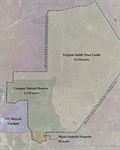
The protected land adjoining the northeast corner of campus is officially part of the UC Natural Reserve System now that the UC Board of Regents gave the proposed reserve final approval today at its January meeting.
The Merced Vernal Pools and Grasslands Reserve is the 39th reserve in the statewide system, adding more than 6,500 acres to the more than 750,000 acres already being conserved and studied. UC Merced’s reserve, though, is the first one in the San Joaquin Valley, and the first one in the heart of the greater Central Valley.
 “When I was hired in 2002 as the first director of the Sierra Nevada Research Institute, it was a goal to get this piece of land into the reserve system, so it feels great to finally have it done,” Vice Chancellor for Research Sam Traina said.
“When I was hired in 2002 as the first director of the Sierra Nevada Research Institute, it was a goal to get this piece of land into the reserve system, so it feels great to finally have it done,” Vice Chancellor for Research Sam Traina said.
He pointed out that UC Merced’s reserve is one of the largest contiguous vernal pools complexes left in the state, so it’s an important piece of land from scientific and conservation perspectives.
“On it, we find a wide range of ancient soils up to 3 million years old, about six endangered species and an array of native plants. It’s a unique ecological component of the UC system,” Traina said.
 This is actually UC Merced’s second natural reserve – the Yosemite Field Station being the first.
This is actually UC Merced’s second natural reserve – the Yosemite Field Station being the first.
The approval cements the UC’s commitment to conserving this land, which was placed in reserve before the campus was even built.
“The approval doesn’t change our plans or our care for the property. The land has always been preserved – that was part of the mitigation agreement for building our campus here,” said Faculty Reserve Director Professor Martha Conklin. “We’ve always wanted to use it for research and education, and we’ve always been careful with it. We graze cattle on the land – an accepted best practice for maintaining the integrity of the vernal pools system. Weed control is even done manually – we don’t spray herbicides on the property.”
Because the reserve system promotes research, education and conservation, being part of the UC Reserve System, she and Traina agreed, will raise the reserve’s visibility and attract researchers from around the UC and around the world.
 For example, Professor Steve Hart, who teaches ecology, said he plans to study how the mysterious mima mounds formed, seeing if excluding gophers affects their structure; how the soil ecosystem formed; how the microbial biology and biogeochemistry of vernal pools are affected by the big seasonal swings in temperature and water availability.
For example, Professor Steve Hart, who teaches ecology, said he plans to study how the mysterious mima mounds formed, seeing if excluding gophers affects their structure; how the soil ecosystem formed; how the microbial biology and biogeochemistry of vernal pools are affected by the big seasonal swings in temperature and water availability.
Professor Jessica Blois will study the small mammals that call the reserve lands home.
“This spring I’m teaching Ecosystems of California, and we have a field trip out to the reserve planned in April,” Blois said. “This class is for freshmen and sophomores, so it will be nice to introduce them to the reserve right off the bat and show them it’s right on their doorstep. It’s a nice part of their heritage as UC Merced students.”
Plans also call for opening up the land – in a controlled way – to the public.
“We are interested in outreach, but have to be careful about allowing people on the property,” Conklin said. “We’re considering an interpretive center where the public can come and learn about the ancient soils, the native plants and the animals living there. And we’re thinking about elevated walkways, which would allow people to see the vernal pools in their seasons without having to walk through mud or trample vegetation.”
Reserve Manager Chris Swarth has already been working toward opening the reserve on a guided basis.
“I’m organizing field trips and meeting with professors and trying to make them aware of the opportunities on the reserve,” Swarth said. “I take students out and I lead, once or twice a month, an open walk on the reserve for students and faculty members. Many say ‘Wow, I’ve been here for years but it’s the first time I’ve been out here. I had no idea it was so beautiful.’”
Lorena Anderson

Senior Writer and Public Information Representative
Office: (209) 228-4406
Mobile: (209) 201-6255






